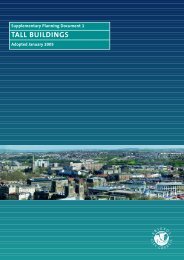Discover the Orpheus Mosaic from Newton St Loe (pdf, 0.5 MB)
Discover the Orpheus Mosaic from Newton St Loe (pdf, 0.5 MB)
Discover the Orpheus Mosaic from Newton St Loe (pdf, 0.5 MB)
Create successful ePaper yourself
Turn your PDF publications into a flip-book with our unique Google optimized e-Paper software.
The <strong>Orpheus</strong> <strong>Mosaic</strong> <strong>from</strong> <strong>Newton</strong> <strong>St</strong> <strong>Loe</strong><br />
The <strong>Orpheus</strong> mosaic <strong>from</strong> <strong>Newton</strong> <strong>St</strong> <strong>Loe</strong> was built by<br />
<strong>the</strong> Romans, almost destroyed by <strong>the</strong> Great Western<br />
Railway and in store for over 100 years.<br />
The History<br />
In 1837 a Roman villa was uncovered at <strong>Newton</strong> <strong>St</strong> <strong>Loe</strong> near Bath, during <strong>the</strong> construction of <strong>the</strong><br />
Great Western Railway. The remains included several mosaic floors, one of which illustrated <strong>the</strong><br />
story of <strong>Orpheus</strong>, a famous mythical poet and musician, charming a circle of wild animals.<br />
The <strong>Orpheus</strong> mosaic was lifted and re-laid at Keynsham Railway <strong>St</strong>ation where it remained until<br />
1851, when it was donated to <strong>the</strong> Bristol Institution, a forerunner of <strong>the</strong> Bristol Museum & Art<br />
Gallery. In 1871 <strong>the</strong> Institution moved to new premises and <strong>the</strong> mosaic remained in storage.<br />
Repeated moves to different stores left <strong>the</strong> floor in a fragmentary state - it was last laid out in <strong>the</strong><br />
1930s, <strong>the</strong>n put away again and thought to have been completely lost. After World War II <strong>the</strong><br />
mosaic, still stored away, endured both <strong>the</strong> ravages of time and a fire and, until recently, was<br />
considered beyond reconstruction. Between 1992 and 2000, members of <strong>the</strong> Association for <strong>the</strong><br />
<strong>St</strong>udy and Preservation of Roman <strong>Mosaic</strong>s (ASPROM) painstakingly identified its fragments and<br />
proved more of it survived intact than previously thought. In 2000, <strong>the</strong> mosaic was carefully<br />
pieced toge<strong>the</strong>r and put on temporary display at Bristol Museum & Art Gallery for <strong>the</strong> first time in<br />
70 years. Since <strong>the</strong>n, <strong>the</strong> mosaic has been in store where it has been made more easily available<br />
to several researchers, however, <strong>from</strong> 3 August 2013, visitors to <strong>the</strong> museum will once more be<br />
able to see <strong>Orpheus</strong> charming wild animals.<br />
The Design<br />
Floors made of small cubes or tesserae have been produced for over 2000 years. Designs would<br />
have been chosen <strong>from</strong> a pattern book and a highly skilled craftsman would produce <strong>the</strong> most<br />
artistic and complicated pieces. Their apprentices worked on plain borders, backgrounds and<br />
repetitive patterns.<br />
One of only nine identified ‘<strong>Orpheus</strong> mosaics’ in Britain, <strong>Orpheus</strong> is shown seated on a bench<br />
playing a kithara - a type of lyre. He wears a cap, belted tunic, cloak and high boots. On <strong>the</strong> right<br />
a fox leaps up to <strong>the</strong> kithara. The circular frieze shows seven animals running to or <strong>from</strong> each<br />
o<strong>the</strong>r. Trees separate <strong>the</strong> animals, a lion, a hind, a bear, a bull, a feline (possibly a pan<strong>the</strong>r), a<br />
leopard and a stag. Designs using circles of animals with <strong>Orpheus</strong> are peculiar to Britain: this<br />
may be <strong>the</strong> earliest, dating <strong>from</strong> <strong>the</strong> late AD200s to <strong>the</strong> early AD300s. The sense of movement<br />
achieved in <strong>the</strong> animals and <strong>the</strong> elaborate colouring of <strong>the</strong> figure of <strong>Orpheus</strong> is unparalleled. The<br />
design may have been modified at some point: <strong>the</strong> animals are arranged in pairs, except for <strong>the</strong><br />
bear, and some are separated by trees, o<strong>the</strong>rs not. Was <strong>the</strong> bear an afterthought or was <strong>the</strong><br />
design reduced to seven animals <strong>from</strong> eight?
Roman sites and museums with Roman<br />
collections<br />
King's Weston Roman Villa<br />
Long Cross, Lawrence Weston, Bristol BS11 0LP<br />
Website: http://www.bristol.gov.uk/page/leisure-and-culture/kings-weston-roman-villa<br />
The Roman Baths, Bath<br />
Abbey Churchyard, Bath, Bath & N.E. Somerset BA1 1LZ<br />
Website: http://www.romanbaths.co.uk<br />
The remains of a Roman baths and temple complex built around hot springs.<br />
National Roman Legion Museum<br />
High <strong>St</strong>reet, Caerleon, Gwent NP18 1AE<br />
Website: http://www.museumwales.ac.uk<br />
Roman antiquities and displays about military life in Britain under Roman control.<br />
Corinium Museum<br />
Park <strong>St</strong>reet, Cirencester, Gloucestershire GL7 2BX<br />
Website: http://www.coriniummuseum.org<br />
A collection of Roman antiquities including large mosaic floors, with reconstructions of a<br />
Roman dining room, kitchen and craftsman's workshop.<br />
Chedworth Roman Villa<br />
Yanworth near Cheltenham, Gloucestershire GL54 3LJ<br />
Website: http://www.nationaltrust.org.uk/chedworth-roman-villa<br />
The remains of one of <strong>the</strong> largest Roman-British villas in <strong>the</strong> country. Visitors can see<br />
mosaics, two bathhouses, a hypocaust and latrine!<br />
Related websites<br />
www.asprom.org<br />
ASPROM (Association for <strong>the</strong> <strong>St</strong>udy and Preservation of Roman <strong>Mosaic</strong>s) - a wide variety of<br />
articles relating to mosaics in Britain, including design, construction, and <strong>the</strong> buildings in<br />
which <strong>the</strong>y have been discovered.<br />
http://www.bbc.co.uk/history/ancient/romans<br />
A series of articles about different aspects of Roman history including <strong>the</strong> Romans in Britain.<br />
http://www.bbc.co.uk/history/handsonhistory/romans<br />
This site is designed for Key <strong>St</strong>age 2 pupils but is just as interesting and as much fun for<br />
adults to explore!<br />
http://www.britishmuseum.org<br />
Explore <strong>the</strong> Roman and Romano-British collections at <strong>the</strong> British Museum.
















